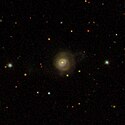IC 1460
| Galaxie IC 1460 | |
|---|---|
 | |
| SDSS-Aufnahme | |
| AladinLite | |
| Sternbild | Fische |
| Position Äquinoktium: J2000.0, Epoche: J2000.0 | |
| Rektaszension | 22h 57m 04,1s[1] |
| Deklination | +04° 40′ 37″[1] |
| Erscheinungsbild | |
| Morphologischer Typ | E2[1][2] |
| Helligkeit (visuell) | 14,4 mag[2] |
| Helligkeit (B-Band) | 15,1 mag[2] |
| Winkelausdehnung | 0,5′ × 0,5′[2] |
| Flächenhelligkeit | 12,2 mag/arcmin²[2] |
| Physikalische Daten | |
| Rotverschiebung | 0.024357 ± 0.000137[1] |
| Radialgeschwindigkeit | (7302 ± 41) km/s[1] |
| Hubbledistanz vrad / H0 | (333 ± 23) · 106 Lj (102,1 ± 7,2) Mpc [1] |
| Geschichte | |
| Entdeckung | Stéphane Javelle |
| Entdeckungsdatum | 9. Oktober 1891 |
| Katalogbezeichnungen | |
| IC 1460 • PGC 70086 • CGCG 405-017 • MCG +01-58-015 • IRAS 22545+0424 • KUG 2254+044 • 2MASX J22570408+0440367 • Mrk 923 • GALEXASC J225704.05+044037.3 | |
IC 1460 ist eine elliptische Galaxie vom Hubble-Typ E2 im Sternbild Fische auf der Ekliptik. Sie ist schätzungsweise 333 Millionen Lichtjahre von der Milchstraße entfernt und hat einen Durchmesser von etwa 50.000 Lj.
Im selben Himmelsareal befindet sich u. a. die Galaxie NGC 7422.
Das Objekt wurde am 9. Oktober 1891 von Stéphane Javelle entdeckt.[3]
Weblinks
Einzelnachweise
Auf dieser Seite verwendete Medien
Autor/Urheber: Sloan Digital Sky Survey, Lizenz: CC BY 4.0
The sky image is obtained by Sloan Digital Sky Survey, DR14 with SciServer.
Angle of view: 4' × 4' (0.3" per pixel), north is up.
Details on the image processing pipeline: https://www.sdss.org/dr14/imaging/jpg-images-on-skyserver/



